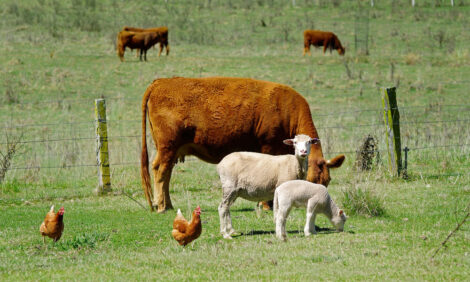



CME: New Concerns in Crop Markets to Hit Livestock Sector
US - Dry and hot, these are the words of Len Steiner and Steve Meyer regarding recent conditions over the mid-west.They report ProFarmer feedback of low soybean pod counts in Iowa and Illinois and expect cattle the cattle futures rally to be halted, as well as pig and poultry feed, possibly slowing hog expansion.
Mr Meyer and Steiner write: The eruption in corn and soybean futures markets ON Monday was not caused by USDA’s weekly crop condition ratings but those ratings did, we think, confirm the concern that drove prices sharply higher. The rally began as soon as electronic trading for Monday began on Sunday evening and generally gained strength all day on Monday.
Corn Markets
Soybeans led the way with the November contract gaining $0.61-1/2 to close at $13.89-1/2, $2.22-3/4/bushel higher than the lowest contracts most recent lowest close of $11.65-3/4 on August 7.
December corn closed the day’s trading at $5.00-1/2, up $0.30 from Friday’s close. The percentage of soybeans rated as being in good or excellent condition dropped to 59 per cent in Monday’s Crop Progress Report, its lowest such ratings of the year and the first time since June that the good-excellent share has been below the average of the past 10 years.
The share of good-excellent rated corn acres fell below 60 per cent as well. This week’s 59 per cent is down 2 per cent from a week ago but is still nearly 3 per cent above the average for the week over the past 10 years.
So why the sudden reaction?
First, the forecast for much of the Midwest is for very high temperatures this week with little or no precipitation in sight. We have been talking about the advancing dry conditions from northern Illinois westward for some time.
Last week’s Drought Monitor map from the National Weather Service indicates that sizable chunks of Iowa and northern Missouri are now in moderate drought conditions and parts of northeast Nebraska are again in severe drought.
Good spring moisture is long gone in these areas. The game changer, though, is heat. Where on year ago the Midwest was dry and abnormally hot beginning in June, those excessive temperatures have not been seen for any extended stretches this summer.
Until now. We aren’t agronomists but our experience is that corn and soybean plants can handle some heat if moisture is available and can handle some dryness if it is not too hot but the combination of dry and hot is lethal.
This rally comes on the heals of last week’s announcement of the results of ProFarmer’s annual crop tour that predicted generally good yields for both corn and soybeans and found excellent conditions in the eastern Cornbelt.
But, the ProFarmer scouts also found some shockingly low pod counts on soybeans with Iowa and Illinois figures lower than last year! Those numbers fueled the fire as well.
Livestock and Poultry?
The first thing it means is a likely halt to the rally in feeder cattle futures. Since the demand for feeder cattle is derived from the demand for fed cattle based on the cost of adding 500-800 pounds of weight, higher corn prices reduce the value of those feeders. Feeder futures had most likely made a top last week but Monday’s limit-down day in November futures confirmed that top.
Second, the huge rally in soybeans has carried every soybean meal futures contract through June 2014 to new contract life highs. The weekly chart has now established strong support near $400 per ton with the upside objective being resistance off the July 2012 highs near $550 and the early July 2013 spike high at $544.
Higher soybean meal prices hit the poultry industry harder than any others since birds require more and higher quality protein. Hogs would be second on that list though distillers grains and synthetic amino acids can be carefully used to replace much —and even all — soybean meal in pig diets.
These impacts are especially large when meal is carrying the value load as it has been for some time.
Lower feeder cattle prices will put some pressure on calf prices but we doubt that it will slow down beef cow herd expansion much since that is such a long-run decision. Hog expansion may be slowed but even at these feed ingredient prices, lean hogs futures are offering profits for 2014. It will be hard to resist adding some sows.









